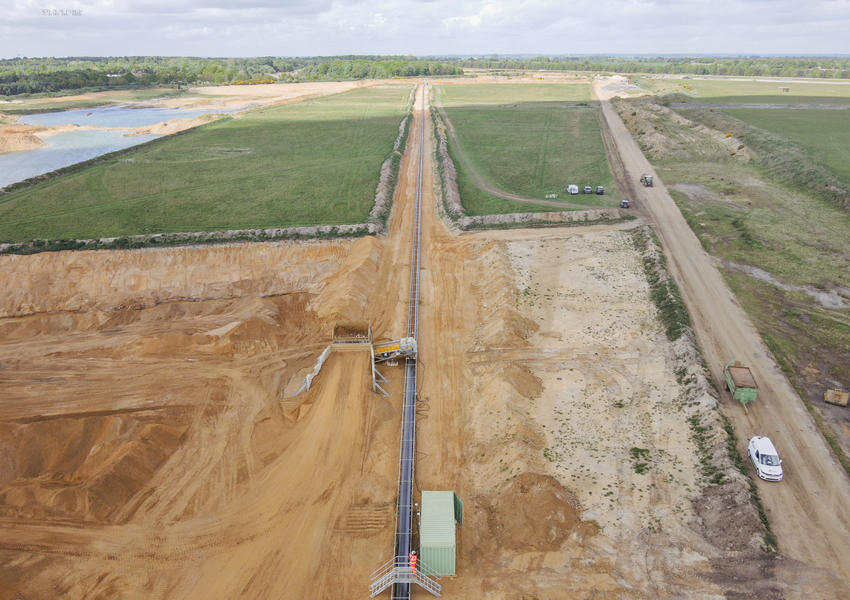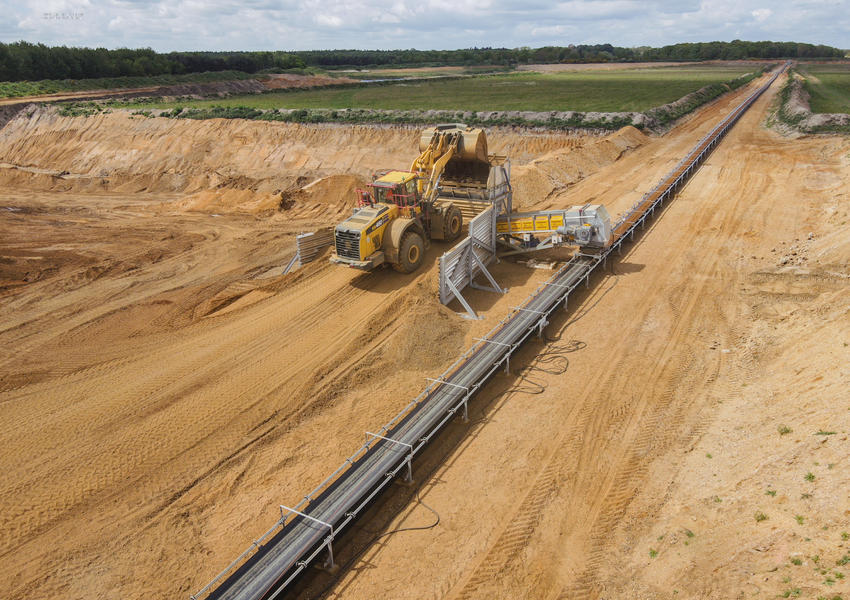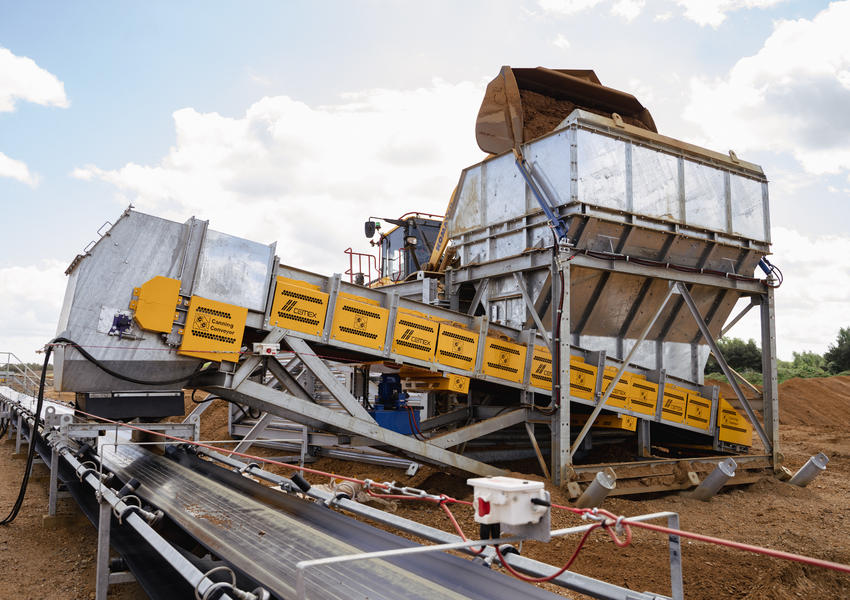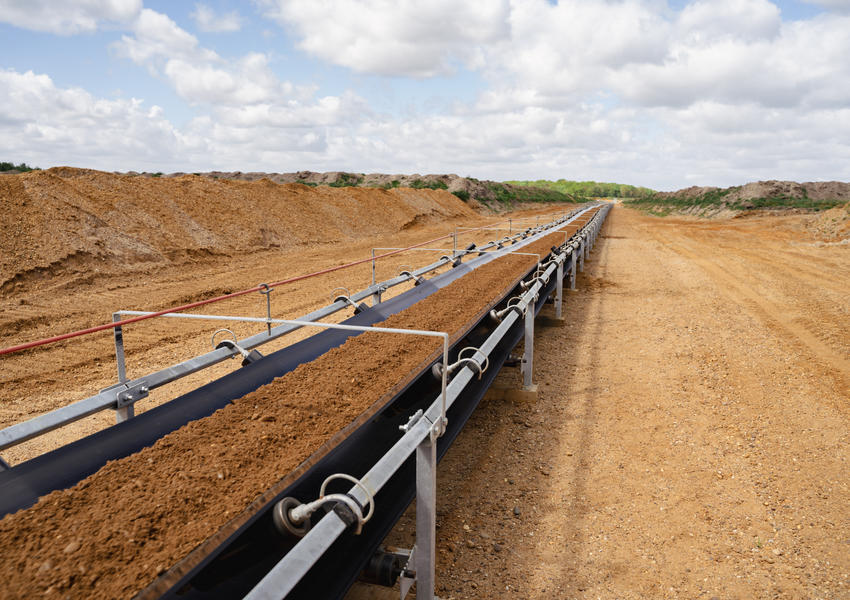Canning helps CEMEX reduce their C02 emissions at Swinderby Quarry.
Canning Conveyor have recently supplied and installed a mile long conveyor system which included a 20-tonne hopper feeder, a number of field conveyors and a radial stockpiler at Swinderby Quarry.
Owned and operated by CEMEX, this installation represents a sizeable investment and a significant contribution to reducing CO2 emissions and fuel use at the site. This is the latest development from the global buildings materials supplier as it leads the way in sustainable operations in line with its Future in Action programme.
Canning designed, manufactured, and installed the modular stringer field conveyor system to operate at 400tph on a 900mm wide belt to carry sand and gravel at a maximum lump size of 150m with a density of 1.6t/m.
The conveyor system is made up of 5 separate conveyors that are fed from a 20-tonne hopper feeder which is fitted with wheels and a towing point to allow them to be moved.
The hopper infeed features a grizzly screen with an aperture of 150mm to separate and collect the over-sized product and is also actuated by hydraulic cylinders to pivot up and eject collected material when necessary and includes the facility of being unhooked and separated from the hydraulics for transportation.
Conveyor System:
The system at Swinderby is a modular stringer field conveyor system that offers true flexibility throughout and is designed for ease of transportation and assembly at site.
The modular stringer sections are fabricated from rolled hollow section, designed to be robust and give high strength torsional rigidity. Each section is 3m in length with bolted connections that makes the design easy to assemble and maintain.
All modular section conveyors have been designed throughout to use common parts, thereby reducing the need to keep high stock levels of spares.
A simple feed boot is fitted at each conveyor tail, while a chute at the head of the conveyor will include a crash box design which will help reduce wear while maintaining efficient discharge without spillage
A loop tensioning device will be incorporated at the head end of each conveyor, with a standalone GTU included for conveyor CV2.
At the head end a gradient section has been incorporated which will ensure a smooth transition from the field conveyor.
Primary & secondary scrapers will be fitted at the head drum of each conveyor to ensure efficient belt cleaning while ploughs will be fitted to prevent any build up on the tail drum.
The primary conveyor – CV1 is a Wing Conveyor and is configured for easy movement or a facilitating a reduction in length if required. This conveyor feeds onto CV2 which is 900m in length with a 900mm wide belt and incorporates a moveable feed section to allow multiple loading points. Driven by a 90Kw drive this conveyor is made up of 3m modular sections and is fitted with primary scraper and a secondary scraper to maximise cleaning. A heavy-duty tail-end loading section is fitted with impact rollers to reduce the impact of the material with the tail pulley.
CV3 is 390m in length and receives material from CV2 and feeds on CV4; both these conveyors are of identical specification and offer the same performance.
CV4 is 117m in length, this conveyor discharges onto the radial stockpile conveyor which will with a continuous feed provide a kidney shape stockpile of 7,000t. This conveyor is 900mm wide a 100m in length and will incline up to 5m.
Achieving sustainability targets:
As CEMEX move into the next phase of extraction this will minimize the use of diesel-powered dumpers, saving a projected 300,000 litres of fuel per year, the equivalent of taking 172 cars off the road. There will also be decreased dust and noise at the quarry.
Steve Sheller, CEMEX’s Head of Business Development for West Europe Materials, commented: “Swinderby is a crucial site in our portfolio; it supports our customers in the Birmingham metro-market and wider Midland’s area, and has a considerable reserve potential of more than 10 million tonnes.
“We are therefore investing heavily into the site to ensure it can meet demand for years to come, while also achieving the sustainability targets set as part of our Future in Action global strategy. By using a conveyor, we can cut CO2 emissions – we have calculated a ~50% reduction in CO2 per tonne of aggregate, when comparing to the anticipated consumption to work the next phase of the quarry using mobile plant, alongside further efficiency, and cost savings. Considering forecasted production figures this is a total CO2 saving of approximately 74%.”



